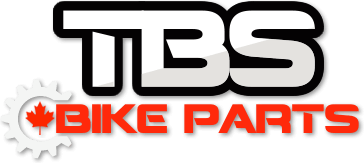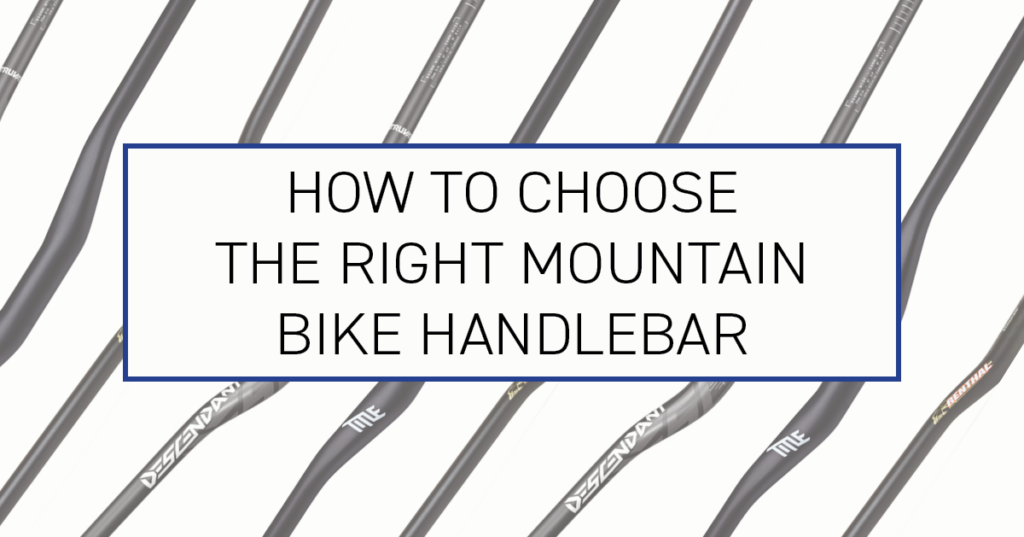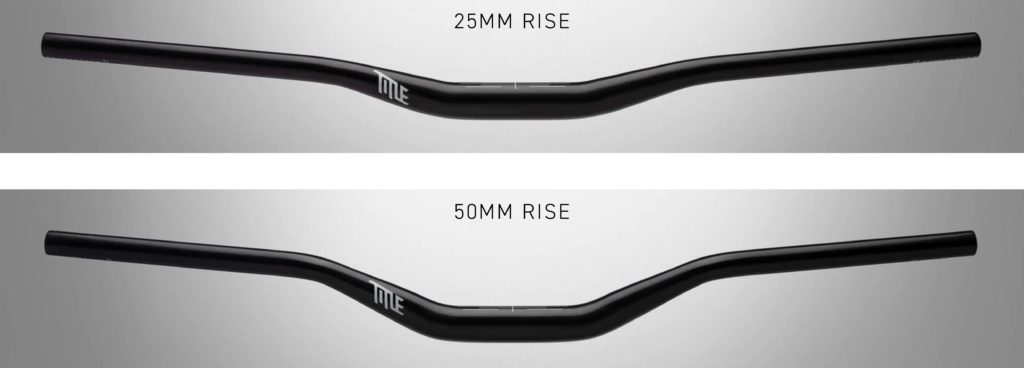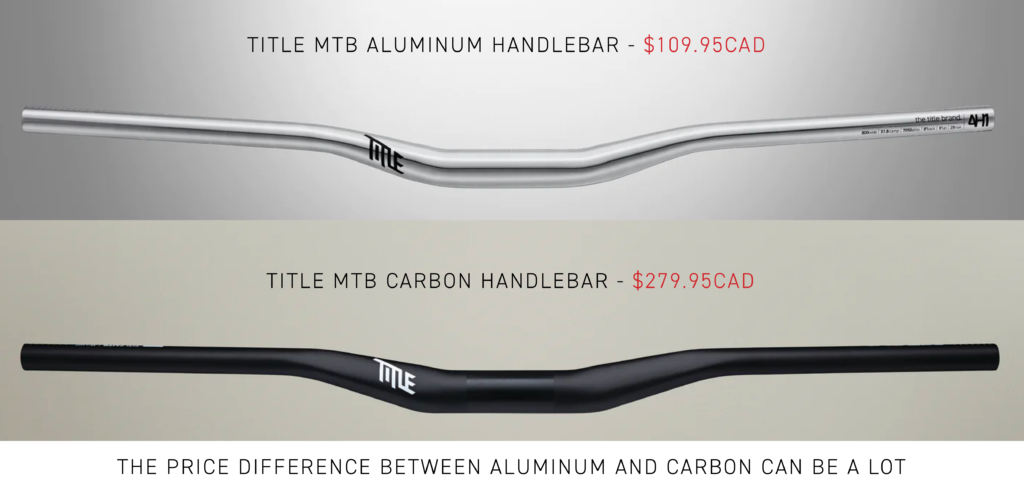Choosing the right MTB handlebar involves considering factors such as your riding style, bike geometry, personal preferences, budget, and more. In the following article we are going to go over all of the factors and steps to help you choose the right MTB handlebar.
How to Choose the Right Mountain Bike Handlebar
1. Determine your riding style:
MTB handlebars come in different shapes and sizes, each designed for a particular riding style. Different handlebar styles can affect how a rider positions their body on the bike, how much control they have over the bike, and how comfortable they are while riding. Here are some examples of MTB riding styles and how they relate to handlebar choice:
- Cross-Country (XC) Riding: XC riders typically focus on speed and endurance, and their handlebar choice often reflects this. Many XC riders prefer flat handlebars, which provide a more aerodynamic riding position and allow for greater power transfer through the arms. Flat handlebars can also be narrower, which can help with maneuverability and navigating tight turns.
- Trail Riding: Trail riding involves a mix of climbs, descents, and technical terrain. Trail riders may opt for wider handlebars with a slight rise to provide more control and leverage on the bike. These handlebars allow for a more upright riding position, which can be more comfortable on longer rides. Some trail riders may also choose handlebars with a sweep (angled backward) to provide a more natural hand position.
- Downhill (DH) Riding: DH riders focus on descending as quickly as possible over steep, technical terrain. DH riders often use wider handlebars with a significant rise to provide maximum control and stability. The wider handlebars help to maintain stability at high speeds and provide more leverage for steering and braking.
- Enduro Riding: Enduro riding involves a mix of trail and DH riding, with timed stages and untimed climbs. Enduro riders often use handlebars that strike a balance between the control and stability of DH handlebars and the maneuverability of trail handlebars. These handlebars may have a slight rise and be slightly wider than trail handlebars to provide more control on technical descents.
The choice of handlebars in regards to MTB riding style is a personal preference, and riders should choose what feels most comfortable and effective for their specific riding style and terrain.
2. Consider bike geometry:
The geometry of a mountain bike can affect how the bike handles and performs, and this can have an impact on handlebar choice. The geometry of a mountain bike includes factors such as the frame size, head tube angle, seat tube angle, chainstay length, and wheelbase. Here are some examples of how MTB geometry can relate to handlebar choice:
- Frame Size: The size of the mountain bike frame can affect the width and rise of the handlebars. For example, larger frames may have wider handlebars to provide more stability and control, while smaller frames may have narrower handlebars to provide more maneuverability.
- Head Tube Angle: The head tube angle determines the steering angle of the bike, and this can affect handlebar choice. A steeper head tube angle (around 70 degrees or more) may work well with flat handlebars, while a slacker head tube angle (around 65 degrees or less) may work better with riser handlebars to provide a more upright riding position.
- Seat Tube Angle: The seat tube angle affects the rider’s position on the bike, and this can also affect handlebar choice. A steeper seat tube angle (around 75 degrees or more) may work well with flat handlebars to provide a more aerodynamic riding position, while a slacker seat tube angle (around 70 degrees or less) may work better with riser handlebars to provide a more comfortable riding position.
- Chainstay Length and Wheelbase: The chainstay length and wheelbase affect the stability and maneuverability of the bike, and this can also have an impact on handlebar choice. Longer chainstays and wheelbases may work well with wider handlebars to provide more stability, while shorter chainstays and wheelbases may work better with narrower handlebars to provide more maneuverability.
Ultimately, the choice of handlebars for a mountain bike depends on a variety of factors and riders should experiment with different handlebar options to find what works best for them.
3. Choose the right width:
MTB handlebars come in various widths, and the choice of handlebar width can affect the rider’s control, comfort, and handling of the bike. Here are some common handlebar widths and their characteristics:
- Narrow handlebars: Narrow handlebars are typically between 680mm to 720mm wide. They offer more precise handling and are ideal for cross-country riding, where speed and efficiency are important.
- Medium handlebars: Medium handlebars are usually between 720mm to 780mm wide. They offer a balance between control and stability, making them suitable for trail riding.
- Wide handlebars: Wide handlebars are usually between 780mm to 820mm wide. They offer the most stability and control, making them ideal for downhill and aggressive riding.
When choosing a handlebar width, consider your riding style, terrain, and personal preferences. A wider handlebar can provide more stability and control on technical terrain, but it may feel too wide for riders with smaller shoulders or a narrow body frame. A narrower handlebar can be more efficient and easier to maneuver, but it may not provide enough stability on rough terrain.
4. Decide on the rise:
MTB handlebars come in different rises, which refer to the height of the bar relative to the stem and the bike’s frame. The rise of the handlebar affects the rider’s position on the bike, as well as the bike’s handling and control. A higher rise offers a more upright position, while a lower rise provides a more aggressive stance. Here are some of the most common MTB handlebar rises and their characteristics:
- Flat handlebars: Flat handlebars have zero rise and are parallel to the ground. They are typically found on cross-country and endurance mountain bikes. Flat handlebars offer a low and aerodynamic riding position, which is ideal for speed and efficiency.
- Low-rise handlebars: Low-rise handlebars have a slight rise, usually ranging from 5mm to 30mm. They are commonly used on trail and all-mountain bikes. Low-rise handlebars provide a more upright riding position compared to flat handlebars, which can improve comfort and control.
- Mid-rise handlebars: Mid-rise handlebars have a higher rise than low-rise handlebars, usually ranging from 30mm to 50mm. They are suitable for aggressive trail riding and all-mountain riding, offering a more upright position and better control.
- High-rise handlebars: High-rise handlebars have the highest rise, typically exceeding 50mm. They are commonly used on downhill bikes and provide a very upright riding position, allowing the rider to easily shift their weight and control the bike.
In general, handlebar rise is a matter of personal preference and riding style. A lower rise handlebar will put you in a more aggressive position, which is ideal for speed and control on technical terrain. A higher rise handlebar will provide a more upright position, which is better for comfort and stability. Consider your riding style and terrain when choosing the handlebar rise that works best for you.
5. Choose the right backsweep:
MTB handlebars come in different shapes, and one of the most significant differences is the amount of backsweep. Backsweep refers to the degree to which the handlebar sweeps backward from the stem clamp area. Here are some common backsweep measurements and their characteristics:
- Flat handlebars: Flat handlebars have no backsweep, meaning they are completely straight. They offer a more aggressive riding position and are best suited for cross-country and endurance riding.
- 5-9 degrees backsweep: MTB handlebars with 5-9 degrees of backsweep are commonly used for trail riding. They offer a slightly more relaxed riding position than flat handlebars, making them a good compromise between comfort and control.
- 10-13 degrees backsweep: Handlebars with 10-13 degrees of backsweep are suitable for all-mountain riding. They provide a more upright position, which can help improve control and comfort on technical terrain.
- 14+ degrees backsweep: Handlebars with 14 degrees or more of backsweep are typically used for downhill riding. They offer the most relaxed position, which is ideal for steep descents and rough terrain.
In general, the more backsweep a handlebar has, the more comfortable it will be for longer rides, as it puts less stress on the wrists and shoulders. However, a higher degree of backsweep can reduce the rider’s leverage and control over the bike, making it less suitable for technical riding. Ultimately, the amount of backsweep you choose will depend on your riding style, the terrain you ride on, and your personal preferences. It’s best to try out different handlebars with different degrees of backsweep to see what works best for you.
6. Check the material:
Mountain bike handlebars can be made from a variety of materials, each with its own benefits and drawbacks. Here are some of the most common MTB handlebar material options:
- Aluminum: Aluminum is a popular choice for MTB handlebars because it is lightweight, strong, and affordable. Aluminum handlebars are also easy to find and come in a variety of shapes and sizes. However, aluminum can be prone to fatigue over time, and may not be as comfortable as other materials.
- Carbon fiber: Carbon fiber is a high-end material used in many MTB components, including handlebars. Carbon fiber handlebars are lightweight, strong, and can offer a more comfortable ride than aluminum. They can also be engineered to have specific flex patterns that can help absorb vibrations and reduce arm fatigue. However, carbon fiber handlebars are more expensive than aluminum and can be more prone to damage from impacts.
- Titanium: Titanium handlebars are less common than aluminum or carbon fiber, but they are a good option for riders who want a strong, durable, and lightweight handlebar. Titanium is also corrosion-resistant, making it a good choice for riders who frequently ride in wet conditions. However, titanium handlebars are more expensive than aluminum and can be more difficult to find.
- Steel: Steel handlebars are the heaviest option but can be a good choice for riders who prioritize durability and comfort over weight. Steel handlebars can be more forgiving on rough terrain, and can offer a more comfortable ride than aluminum or carbon fiber. However, steel handlebars can be less responsive than other materials and may be less common than aluminum or carbon fiber.
Ultimately, the choice of handlebar material for a mountain bike depends on the rider’s personal preference, riding style, and budget. Riders should consider the benefits and drawbacks of each material before making a decision.
7. Check stem compatibility:
MTB handlebars and stems must be compatible to ensure safety and optimal performance. Here are some key considerations for handlebar and stem compatibility:
- Clamp diameter: The clamp diameter of the stem must match the clamp diameter of the handlebar. The two most common clamp diameters for MTB handlebars are 31.8mm and 35mm. The stem’s clamp diameter should match the handlebar’s clamp diameter for a secure fit.
- Handlebar shape: The shape of the handlebar should be compatible with the stem. Flat handlebars, for example, require a stem with zero degree rise, while riser handlebars require a stem with some degree of rise.
- Length: The length of the stem can affect the bike’s handling and control. A shorter stem will provide more responsive handling, while a longer stem will offer more stability. Choose a stem length that works best for your riding style and preferences.
- Angle: The angle of the stem affects the rider’s position on the bike. A stem with a positive angle will raise the handlebar, providing a more upright riding position. A stem with a negative angle will lower the handlebar, providing a more aggressive position.
- Stack height: The stack height of the stem determines how much the handlebar is raised or lowered in relation to the bike’s frame. A lower stack height will lower the handlebar, while a higher stack height will raise it.
When choosing a stem and handlebar for your MTB, make sure they are compatible with each other and your bike’s geometry. It’s also important to properly tighten the bolts that secure the stem and handlebar to prevent any slipping or loosening during riding. If you’re unsure about the compatibility of your stem and handlebar, consult a bike mechanic or contact the manufacturers for advice.
7. Budget:
Budget can be a factor when it comes to choosing the right handlebars for a mountain bike. Different materials and designs can affect the price of the handlebars. Here are some general guidelines to keep in mind when choosing MTB handlebars based on budget:
- Entry-level budget: If you’re on a tight budget, aluminum handlebars are a good choice. They are affordable, widely available, and can be found in a variety of shapes and sizes to suit different riding styles. Flat aluminum handlebars are generally the most affordable option, while riser aluminum handlebars tend to be slightly more expensive.
- Mid-range budget: If you have a bit more to spend, you may want to consider carbon fiber or titanium handlebars. Carbon fiber handlebars are lighter and can offer more comfort than aluminum, while titanium handlebars are strong, durable, and corrosion-resistant. However, both materials are more expensive than aluminum.
- High-end budget: If you have a larger budget and want the best of the best, you may want to consider high-end carbon fiber handlebars. These handlebars are designed to be lightweight, strong, and comfortable, and can be engineered to have specific flex patterns to absorb vibrations and reduce arm fatigue. However, they are the most expensive option and may not be necessary for all riders.
The choice of handlebars should be based on personal preference and riding style, as well as budget. Riders should choose handlebars that feel comfortable and provide the necessary control for their riding style, while also being mindful of their budget.
Our Take
Ultimately, the best way to choose the right MTB handlebar is to try out different options and see which one feels most comfortable and natural for you. Choosing the right MTB handlebar requires careful consideration of your riding style, terrain, personal preferences, and budget. Taking the time to choose the right handlebar can make a significant difference in your riding experience and performance.
Looking to upgrade your mountain bike handlebar? We have both aluminum and carbon options in stock and carry handlebars from Title MTB, Truvativ, and Renthal. Click here to shop our full selection of mountain bike handlebars and stems. Remember that we offer free shipping on all orders over $149CAD in North America. Spend less and ride the best with TBS Bike Parts!
RELATED ARTICLES
HOW TO CHOOSE THE RIGHT MTB STEM
FLAT VS. CLIPLESS MTB PEDALS – ADVANTAGES & DISADVANTAGES
HOW TO CHOOSE THE RIGHT MOUNTAIN BIKE TIRE




